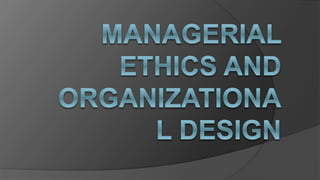
Managerial ethics and organiztional design
- 2. GROUP MEMEBERS: AREEBA SHAFIQUE AYESHA AFZAL KAMRAN SALAM MEHMOOD FIDYAN ANAS ZEESHAN
- 3. WHAT IS ETHICS? The code of moral principles and values that govern the behaviors of a person or group with respect to what is right or wrong.
- 4. Three Views Of Ethics: UTILITARIAN VIEW:- ethical decisions are made on the basis of their outcomes or consequences. RIGHTS VIEW: respects and protects individual liberties and privileges. THEORY OF JUSTICE VIEW: managers impose and enforce rules fairly and impartially.
- 5. CODE OF ETHICS: Formal statement of an organization’s primary values and ethical rules it expects employees to follow. Usually written. Must state in detail acceptable behaviors and actions.
- 7. WHAT IS MANAGERIAL ETHICS? Managerial ethics refers to the moral guidance a supervisor provides his employees. It is a set of principles and rules dictated by upper management that define what is right and wrong in an organization.
- 8. ETHICAL LEADERSHIP: Managers must provide a good role model by: Being ethical and honest at all times. Telling the truth; don’t hide or manipulate information. Admitting failure and not trying to cover it up. Communicating shared ethical values to employees through symbols, stories, and slogans. Rewarding employees who behave ethically and punish those who do not. Protecting employees who bring to light unethical behaviors or raise ethical issues.
- 9. DECISION MAKING: Recognize an ethical issue or situation. Get the facts Evaluate alternative actions. Make a decision and test it. Act and reflect on the outcome .
- 10. MORAL DEVELOPMENT: •Is a measure of an individual’s independence as his/her moral judgment becomes less and less dependent on outside influences •Stages start with making a choice between right and wrong based on personal consequences .
- 11. VALUES: Basic convictions about what is right and wrong. Influence ethical behavior. Values are developed in early years
- 12. ORGANIZATIONALFACTOR THAT AFFECT ETHICAL AND UNETHICAL BEHAVIOR:
- 13. MANAGERS IMPROVING ETHICAL BEHAVIOR: Hire individuals with high ethical standards. Establish codes of ethics and decision rules. Lead by example. Delineate job goals and performance review mechanisms. Provide ethics training. Conduct social audits. Provide support to individuals facing ethical dilemmas
- 14. MANAGING ETHICS AT WORK PLACE: Developing codes of Ethics. Resolving Ethical Dilemma and making ethical decision. Assessing and cultivating ethical culture. Ethics Training.
- 16. WHAT IS ORGANIZATIONAL DESIGN? Organizational design is engaged when managers develop or change an organization's structure. It is basically the process of constructing and adjusting an organization’s structure to achieve its goals.
- 17. Six Key Elements In Organizational Design: A process involving decisions about six key elements: ○ Work specialization ○ Departmentalization ○ Chain of command ○ Span of control ○ Centralization and decentralization ○ Formalization
- 18. 1-Work Specialization: The degree to which tasks in the organization are divided into separate jobs with each step completed by a different person
- 19. 2-Departmentalization: It is the process of grouping activities into departments. Division of labor creates specialists who need coordination. This coordination is facilitated by grouping specialists together in departments
- 20. Departmentalization By Type: Functional : Grouping jobs by functions performed. Product: Grouping jobs by product line. Geographical: Grouping jobs on the basis of territory or geography. Process : Grouping jobs on the basis of product or customer flow. Customer: Grouping jobs by type of customer and needs.
- 21. 3-Chain Of Command: The continuous line of authority that extends from upper levels of an organization to the lowest levels of the organization and clarifies who reports to whom.
- 22. 4-Span Of Control: The number of employees who can be effectively and efficiently supervised by a manager Width of span is affected by: 1. Skills and abilities of the manager and the employees 2. Characteristics of the work being done 3. Similarity of tasks 4. Complexity of tasks 5. Physical proximity of subordinates 6. Standardization of tasks 7. Sophistication of the organization’s information system 8. Strength of the organization’s culture 9. Preferred style of the manager
- 25. 5-Centralization And Decentralization: Centralization: The degree to which decision making is concentrated at a single point in the organization ○ Organizations in which top managers make all the decisions and lower-level employees simply carry out those orders
- 26. Decentralization: The degree to which lower-level employees provide input or actually make decisions Employee Empowerment ○ Increasing the decision-making discretion of employees
- 27. 6-Formalization: The degree to which jobs within the organization are standardized and the extent to which employee behavior is guided by rules and procedures ○ Highly formalized jobs offer little discretion over what is to be done ○ Low formalization means fewer constraints on how employees do their work
- 28. COMMON ORGANIZATIONAL DESIGNS: Two common types of organizational designs are: Traditional designs Contemporary designs
- 29. 1-Traditional Designs: Simple Structure ○ Low departmentalization, wide spans of control, centralized authority, little formalization Functional Structure ○ Departmentalization by function Operations, finance, human resources, and product research and development Divisional Structure ○ Composed of separate business units or divisions with limited autonomy under the coordination and control of the parent corporation
- 30. 2-Contemporary Designs: Team Structures ○ The entire organization is made up of work groups or self-managed teams of empowered employees Matrix Structures ○ Specialists for different functional departments are assigned to work on projects led by project managers ○ Matrix participants have two managers
- 31. Project Structures: ○ Employees work continuously on projects, moving on to another project as each project is completed Boundary less Organization: ○ A flexible and an unstructured organizational design that is intended to break down external barriers between the organization and its customers and suppliers